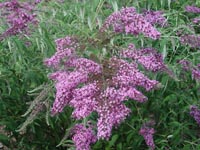Resource Library
Plant of the Week: Summer Lilac (Butterfly Bush)
The University of Arkansas System Division of Agriculture does not promote, support or recommend plants featured in "Plant of the Week." Please consult your local Extension office for plants suitable for your region.
Plant of the Week
Butterfly Bush, Summer Lilac
Latin: Buddleia davidii

As summer gives way to fall, butterflies become more apparent in our gardens. One of the favorite flowers for these showy visitors is butterfly bush, Buddleia davidii. The fragrant blooms of butterfly bush have surged in popularity of late as gardeners rediscover their ability to brighten the perennial border while creating the kind of habitat that butterflies need to flourish.
Butterfly bush is a fast growing, open, usually gangly shrub growing 6 to 10 feet tall with an overall coarse texture. Leaves are finely tooth, gray beneath and somewhat aromatic when crushed.
The spicy, sweet-scented flowers are tiny, tubular affairs with four (sometimes 5) petals which combine into a terminal, pyramidal spike from 8 to 20 inches long. Hundreds of selections have been made with colors primarily centering in shades of blue and purple but pinks, reds, yellows and whites are common. The plants are hardy throughout the state but occasionally during bad winters bushes will die back to the ground.
Plant names tell us a lot of history if we delve into their meaning. Plants of this group were known b y Linnaeus, in fact he established the genus to honor an English botanist and vicar named Adam Buddle (1660-1715). In his writings Linnaeus used the spelling Buddleja, but all but the most dogged botanical purists use the more conventional spelling Buddleia. The species he described was not our modern garden plant, but a species from southern Africa.
The modern garden forms we grow are of Chinese origin and named for the wandering Jesuit priest, Pere Armond David (1826-1900), who had the singular privilege of being assigned the task of studying the natural history of China during the middle years of the 19th century. He first encountered the plant in southwestern China in 1869. It was David who shipped the first live panda back to Paris, where it promptly starved to death because the finicky dietary requirements of the beast were unknown at the time.
The introduction of living plants to the West began with Russian explores in the 19th century. But modern garden forms are primarily from material collected by E. H. Wilson between 1900 and 1908 in western China while traveling for the Veitch nursery in London and the Arnold Arboretum. Wilson, in his 1913 A Naturalist in Western China, describes his trip into northwestern Szechuan Province by stating "Summer Lilac was a wonderful sight - thousands of bushes, each one with masses of violet-purple flowers, delighting the eye on all sides".
The name "summer lilac" was given to the early hybrids by French nurserymen, many of whom developed the French lilacs of that same period. During the 1920's the name "butterfly bush" became popular as a common name and seems to have replaced the first common name for the species.
Summertime travelers in Europe and cooler sections of this country no doubt have noticed butterfly bush has escaped cultivation in the century since its introduction. It is not a common escape in the southeastern states, but the potential does exist.
Dr. Jon Lindstrom, a professor of horticulture at the University of Arkansas, initiated a breeding program in 1999 using several Buddleia species. He is using inter -specific hybridization and hopes to prevent or significantly reduce seed production in his hybrids. Sterile plants not only are better guests in their adopted homelands but are also more floriferous and usually give a better garden display.
Growing buddleias in the garden is easy as long as enough room is provided to make an effective display. It should have at least 6 hours of direct sunlight and a normal garden soil. It is usually best located at the back of the border and planted in masses of three or five. Buddleia bushes should be cut to the ground each winter and regrown from the ground to maintain effective display and good flower production.
Deadheading the blooms will keep the plant in bloom longer. Some gardeners use a summer cut-back approach to controlling plant size and assuring late summer bloom when migrating butterflies are likely to visit. In July or early August when leaving for vacation the plants are cut back half way. In four weeks the plants will be back in full bloom.
By: Gerald Klingaman, retired
Extension Horticulturist - Ornamentals
Extension News - August 16, 2002
The University of Arkansas System Division of Agriculture does not maintain lists of retail outlets where these plants can be purchased. Please check your local nursery or other retail outlets to ask about the availability of these plants for your growing area.